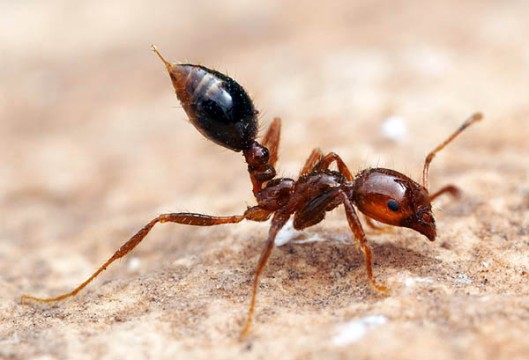Fire Ants Can Be Beneficial?

For years, we have heard and seen the warnings and dangers of fire ants. Actually, only a few members of the genus Solenopsis are fire ants. They are called fire ants, red ants and ginger ants because of their reddish-brown color and because they are stinging ants.
Many of us have been bitten by ants and that’s what most ants do is bite, not sting. Their bites are painful because of the formic acid in their saliva. But stinging ants not only have painful bites but they can and do sting like a bee, which is also extremely painful. If enough fire ants attack at once, their stinging and biting can be lethal, especially if someone is allergic to them.
One fire ant in particular, Solenopsis invicta, is known as the red imported fire ant that has been an invasive species in the United States. They have also spread and are now found in Australia, China and Taiwan. In the United States alone, it is estimated that around $5 billion is spent annually for the treatment of fire ant stings, along with the damage they incur and their control. As for damage, it is estimated that they cause around $750 million a year to produce and livestock.
In the United States, fire ants are mostly found in the southeastern part of country, encompassing an area where about 40 million Americans live. Of those 40 million people living in fire ant territory, over 50% are stung each year.
Fire ants are an aggressive and invasive pest that inflict a lot of damage and cost, so how could they possibly have any benefit except for that of the insecticide companies?
If you or anyone you know has psoriasis, then you will be very interested in the following report:
“Fire ants may be unwelcome guests at picnics, but their venom could prove useful in treating the common autoimmune disease psoriasis. Researchers at Emory and Case Western have developed two experimental compounds inspired by the fire ant that appear promising in treating the skin disorder, which causes painful thickening and rashes.”
“The main toxic ingredients in fire ant venom are called solenopsins. Structurally, these chemicals closely resemble ceramides, which are molecules that help maintain the skin’s barrier against foreign invaders. Ceramides are used in some skin products, but they’re not always beneficial, said Jack Arbiser, a professor at the Emory School of Medicine, in a press release. That’s because they sometimes transform into an inflammatory molecule called sphingosine-1-phosphate (S1P).”
“So, the research team developed two analogs of solenopsin that can’t be converted into S1P. When they tested them in mouse models of psoriasis, they observed that the treated animals had 50% fewer immune cells invading their skin than did the untreated mice. The mice that received the compounds also experienced a 30% drop in skin thickness.”
The report goes on to say that the venoms from other animals have been found to have medically beneficial attributes. When I was in college, I used to volunteer in the venomous animal lab where I milked scorpions, several species of rattlesnakes, several species of cobras and some fer-de-lance. Fer-de-lance are beautifully patterned venomous snake found Central and South America. Over the course of a couple of years, I milked at least 500,000 scorpions. Some of the venom from all of these was used to make anti-venom and some was used for medical research in hopes of finding new ways to treat anything from heart disease to cancer and more.
While fire ants are definitely a bane to millions of Americans, they may also offer hope to nearly 8 million Americans suffering from psoriasis, which currently has no known cure.








Recent Comments